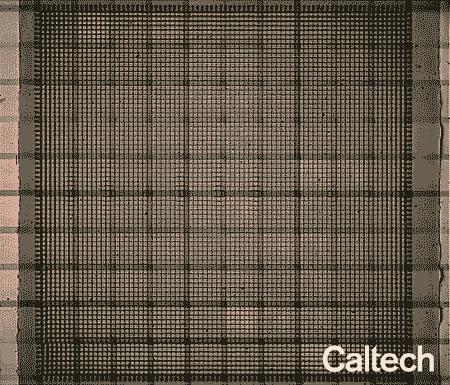New metamaterial morphs into new shapes, taking on new properties

A nanoarchitected metamaterial deforming to create the Caltech icon. Credit: Julia Greer/Caltech Usage Restrictions: For use in news stories only
A newly developed type of architected metamaterial has the ability to change shape in a tunable fashion.
While most reconfigurable materials can toggle between two distinct states, the way a switch toggles on or off, the new material's shape can be finely tuned, adjusting its physical properties as desired. The material, which has potential applications in next-generation energy storage and bio-implantable micro-devices, was developed by a joint Caltech-Georgia Tech-ETH Zurich team in the lab of Julia R. Greer.
Greer, the Ruben F. and Donna Mettler Professor of Materials Science, Mechanics and Medical Engineering in Caltech's Division of Engineering and Applied Science, creates materials out of micro- and nanoscale building blocks that are arranged into sophisticated architectures that can be periodic, like a lattice, or non-periodic in a tailor-made fashion, giving them unusual physical properties.
Most materials that are designed to change shape require a persistent external stimulus to change from one shape to another and stay that way: for example, they may be one shape when wet and a different shape when dry–like a sponge that swells as it absorbs water.
By contrast, the new nanomaterial deforms through an electrochemically driven silicon-lithium alloying reaction, meaning that it can be finely controlled to attain any “in-between” states, remain in these configurations even upon the removal of the stimulus, and be easily reversed. Apply a little current, and a resulting chemical reaction changes the shape by a controlled, small degree. Apply a lot of current, and the shape changes substantially. Remove the electrical control, and the configuration is retained–just like tying off a balloon. A description of the new type of material was published online by the journal Nature on September 11.
Defects and imperfections exist in all materials, and can often determine a material's properties. In this case, the team chose to take advantage of that fact and build in defects to imbue the material with the properties they wanted.
“The most intriguing part of this work to me is the critical role of defects in such dynamically responsive architected materials,” says Xiaoxing Xia, a graduate student at Caltech and lead author of the Nature paper.
For the Nature paper, the team designed a silicon-coated lattice with microscale straight beams that bend into curves under electrochemical stimulation, taking on unique mechanical and vibrational properties. Greer's team created these materials using an ultra-high-resolution 3D printing process called two-photon lithography. Using this novel fabrication method, they were able to build in defects in the architected material system, based on a pre-arranged design. In a test of the system, the team fabricated a sheet of the material that, under electrical control, reveals a Caltech icon.
“This just further shows that materials are just like people, it's the imperfections that make them interesting. I have always had a particular liking for defects, and this time Xiaoxing managed to first uncover the effect of different types of defects on these metamaterials and then use them to program a particular pattern that would emerge in response to electrochemical stimulus,” says Greer.
A material with such a finely controllable ability to change shape has potential in future energy storage systems because it provides a pathway to create adaptive energy storage systems that would enable batteries, for example, to be significantly lighter, safer, and to have substantially longer lives, Greer says. Some battery materials expand when storing energy, creating a mechanical degradation due to stress from the repeated expanding and contracting. Architected materials like this one can be designed to handle such structural transformations.
“Electrochemically active metamaterials provide a novel pathway for development of next generation smart batteries with both increased capacity and novel functionalities. At Georgia Tech, we are developing the computational tools to predict this complex coupled electro-chemo-mechanical behavior,” says Claudio V. Di Leo, assistant professor of aerospace engineering at the Georgia Institute of Technology.
###
The Nature paper is titled “Electrochemically Reconfigurable Architected Materials.” Co-authors include Caltech postdoctoral scholar Carlos M. Portela, as well as Arman Afshar of Georgia Tech and Dennis M. Kochmann of ETH Zurich in Switzerland. This research was funded by Greer's Vannevar-Bush Faculty Fellowship, Kochmann's Office of Naval Research grant, and Di Leo's National Science Foundation CMMI grant.
Media Contact
More Information:
http://dx.doi.org/10.1038/s41586-019-1538-zAll latest news from the category: Materials Sciences
Materials management deals with the research, development, manufacturing and processing of raw and industrial materials. Key aspects here are biological and medical issues, which play an increasingly important role in this field.
innovations-report offers in-depth articles related to the development and application of materials and the structure and properties of new materials.
Newest articles

Properties of new materials for microchips
… can now be measured well. Reseachers of Delft University of Technology demonstrated measuring performance properties of ultrathin silicon membranes. Making ever smaller and more powerful chips requires new ultrathin…

Floating solar’s potential
… to support sustainable development by addressing climate, water, and energy goals holistically. A new study published this week in Nature Energy raises the potential for floating solar photovoltaics (FPV)…

Skyrmions move at record speeds
… a step towards the computing of the future. An international research team led by scientists from the CNRS1 has discovered that the magnetic nanobubbles2 known as skyrmions can be…





















